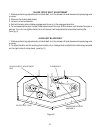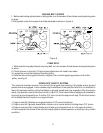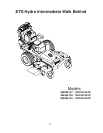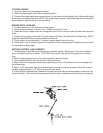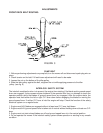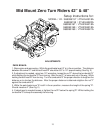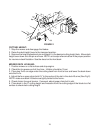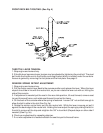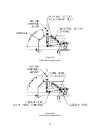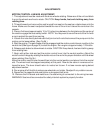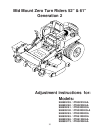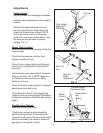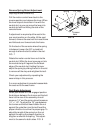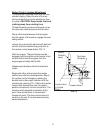29
ADJUSTMENTS
MOTION CONTROL LINKAGE ADJUSTMENT:
1. This adjustment must be made with the drive wheels rotating. Raise rear of the unit and block
it up so the wheels are free to rotate. CAUTION: Keep hands, feet and clothing away from
rotating tires.
2. Tilt seat forward and remove the seat lanyard from seat so the seat can rotate down onto the
frame. Make sure the seat is adjusted toward the rear of the unit so it clears the controls on the
console.
3. Place a 2x4 board approximately 10 to 12 inches long between the foot plate and the center of
the seat to engage the seat safety switch. NOTE: You may want to cover the end of the 2x4 with
a rag to protect the seat from marring.
4. Loosen the nuts directly behind each ball joint on both rods that connect the pump arm to the
motion control assemblies. (See Fig 5b )
5. Start the engine. The park brake must be engaged and the motion control levers must be in the
neutral slot (See figure 6 page10) to start the engine. Run engine at approximately 1/2 throttle.
6. Release park brake to allow wheels to rotate. CAUTION: Keep hands, feet and clothing away
from rotating tires.
7. Begin with either side and put the motion control lever into the neutral position. Adjust the
motion control linkage by rotating the double nuts on the rod in the proper direction until the wheel
stops rotating (See Fig 5b ).
Move the motion control lever forward then into the neutral position and place it into the neutral
slot. The wheel must be stopped completely at this point. Now do the same in reverse and re-
lease the lever. The lever should return to neutral on its own. If not see reverse spring detent
adjustment section.
8. Run engine at full throttle to make sure wheels do not rotate. Readjust if any rotation occurs.
9. Repeat on the opposite side and tighten nuts against ball joints.
10. Remove the 2x4 board and make sure the seat wiring is connected to the wiring harness.
WARNING: Seat must be connected for safety interlock system to properly function.



